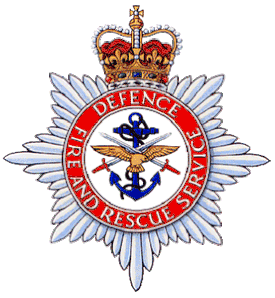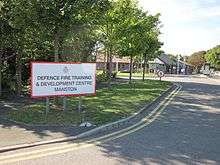Defence Fire and Rescue Service
The Defence Fire and Rescue Service (DFRS) is the primary firefighting and rescue service protecting British defence estates and property. Along with the Royal Air Force Rescue and Firefighting Service, it forms the Ministry of Defence Fire Services.
| DFR / DFRS | |
 | |
| Preventing, Protecting, Responding[1] | |
| Operational area | |
|---|---|
| Country | United Kingdom |
| Address | DFR HQ, Sedgemoor Building, Spur G&H, IDL 54, Marlborough Lines, Monxton Road, Andover, Hampshire, SP11 8HT[2] |
| Agency overview | |
| Established | 1991/2006[3] |
| Website | |
| government page on DFR | |
History
The Ministry of Defence Fire Service was formed on 1 April 1991 by the amalgamation of the Navy Department Fire Prevention Service, Army Department Fire Service, Air Force Department Fire Service and Procurement Executive Fire Service.[4] It was later renamed the Defence Fire Service. It was a civilian organisation which protected mainly domestic sites at RAF, Army and Navy installations.
It later became part of a similarly named umbrella body, the Ministry of Defence Fire Services, which also included the RAF Firefighting and Rescue Service, a military organisation which protected mainly RAF airfields and runways.[5]
The Defence Fire Service was renamed the Defence Fire and Rescue Service in 2004 following the introduction of the Fire and Rescue Services Act. The Act, among other things, acknowledges that fire brigades in the UK do more than just simply fight fire. Most UK brigades changed their names from fire services to fire and rescue services during this period.
Continually run down due to a mixture of a ban on recruitment by the civil service and lack of funding under Army HQ, the lack of investment in staff and vehicles led to calls for privatisation.
Privatisation
In 2014 the Defence Fire Risk Management Project began to look at outsourcing to a private contractor. It was announced in November 2015 that this is the recommended option.
In July 2019, the British Forces Broadcasting Service website "Forces Net" reported that Capita had won the contract[6] and said that:[7]
A privatisation deal will see Capita take over operations at 53 fire stations in the UK and at Ministry of Defence (MOD) sites including Cyprus and the Falkland Islands.
The Fire Service College (itself owned by Capita since February 2013) said the contract would last for 12 years and is worth £525m.[8] It also said that:
Capita will also construct and manage a new, centralised training facility for Defence firefighters at its Fire Service College in Gloucestershire.
although gave no time for this to be completed.[9]
Firefighting and rescue

The DFRS are responsible for:
providing a fire and rescue capability, including airfield rescue and firefighting, and structural fire and rescue firefighting capabilities
and as such look similar to other UK FRS in their appearance and response.
Vehicles
Most appliances (vehicles) are painted red and may have "DEFENCE FIRE SERVICE" or their motto "PREVENTING, PROTECTING, RESPONDING" on the sides of the vehicle.[10] Some appliances may have military number plates (normally ending in "AA" or "AB"), but some have civilian paltes.[11] [12] The usual blue lights and sirens may be used.
Uniform
The uniform of fire personnel is again similar to other UK FRS, with generally a:
- formal uniform (No. 1 dress - for parades etc)
- everyday uniform (for office, training etc)[13]
- firefighting uniform (PPE/'turnout kit')
Training
Both civilian and RAF fire crews are trained in exactly the same way. The training is in line with their local authority fire service counterparts. Traditionally RAF crews were specialists skilled at dealing with live aircraft munitions and airfield crash rescue operations, but they also provided fire prevention and domestic firefighting response on RAF bases and assisted local civilian brigades when called upon. There was, also, often a crossover of roles with civilian Defence Fire Service crews protecting some air bases, and RAF crews protecting purely domestic (non-flying) units.
In the RAF, airmen and women receive their basic military training before going on to train in various "trades" or "areas of expertise" such as mechanics, pilots, electricians, navigators, etc. Firefighting is a "trade" therefore which some airmen/women choose to be trained in.
The main training facility for all MoD firefighters is the Defence Fire Training and Development Centre (was FSCTE) at the former RAF Manston in Kent. Originally the Air Ministry Fire Training School, in 2007 DFTDC became part of the newly created Defence Fire Risk Management Organisation (DFRMO) at Andover, Hampshire, under the command of HQ Land Forces.
"Over the fence" response
As a general rule, the Defence Fire and Rescue Service only operates within the confines of the site it protects. However, as it is not a fire service recognised by the Fire and Rescue Services Act 2004 it has needed legislation under the Armed Forces Act to enable jurisdiction and powers of entry just like any other local authority fire service at incidents involving fire or risk to life. As such there are often local agreements for MoD fire services to cover a certain area around the site they protect and can be called for assistance by their local authority fire service colleagues as and when required.
For instance, in September 2019, fire crew from RAF High Wycombe as well as RAF Police, Thames Valley Police and Buckinghamshire Fire and Rescue Service personnel responded and extinguished a tractor fire.[14]
Organisation
The Defence Fire and Rescue Service is a civilian organisation, however the term 'Defence Fire' may be used colloquially to include military and civilian firefighting activities. According to the gov.uk website, the DFR staff include:[15]
military
- Royal Air Force Trade Group 8 Firefighter
- Royal Navy Aircraft Handler
civilian
- Civil Service (Defence Fire and Rescue Service)
- locally employed civilian and contractor staff.
The DFRS is headed by a Chief Fire Officer (CFO DFR) (as of 2020 - Mr Joel Gray).[16]
Recruitment and Work Conditions
As DFR is a mixture of people, recruitment and conditions differ, but for civilians wishing to join, they would become Civil Servants and thus to apply would need to apply via the Civil Service website.[17]
Other responsibilities
The new MoD fire service is not a fire authority in its own right, but is a statutory authority for the purpose of enforcing fire safety standards (the Regulatory Reform (Fire Safety) Order 2005) at all defence sites.
References
- https://twitter.com/BU954/status/1276930345120776194/photo/1
- https://twitter.com/dfr_fire?lang=en
- https://www.gov.uk/government/groups/defence-fire-risk-management-organisation
- https://nyebevannews.co.uk/royal-navy-army-and-raf-fire-and-rescue-services-privatised/
- Wise, Andrew, ed. (April 2001). "Airfield support set to move to private sector". RAF News (1022). Innsworth: Royal Air Force. p. 3. ISSN 0035-8614.
- https://www.forces.net/news/fire-and-rescue-privatisation-goes-ahead
- https://www.forces.net/news/fire-and-rescue-privatisation-goes-ahead
- https://www.fireservicecollege.ac.uk/news-events/news/2019/capita-signs-525m-fire-and-rescue-service-contract-with-ministry-of-defence/
- https://www.fireservicecollege.ac.uk/news-events/news/2019/capita-signs-525m-fire-and-rescue-service-contract-with-ministry-of-defence/
- https://www.fire-rescue-photos.com/UK-Fire-Rescue-Photos/Non-Local-Authority-Airports-Industrial-and-Preserved/Military-Fire-Rescue-Services/DefenceRAF-Fire-Rescue-Service/DFS-Bicester/i-nKZHBCZ
- https://www.fire-rescue-photos.com/UK-Fire-Rescue-Photos/Non-Local-Authority-Airports-Industrial-and-Preserved/Military-Fire-Rescue-Services/DefenceRAF-Fire-Rescue-Service/DFS-Bicester/i-nKZHBCZ
- https://s3-eu-west-1.amazonaws.com/fire-engine-photos.com/1454.jpg
- https://www.helensburghadvertiser.co.uk/resources/images/4424757.jpg?display=1&htype=0&type=responsive-gallery
- https://twitter.com/RAFHighWycombe/status/1168976698907475968
- https://www.gov.uk/government/groups/defence-fire-risk-management-organisation
- https://twitter.com/CFO_DFR
- https://www.gov.uk/government/groups/defence-fire-risk-management-organisation